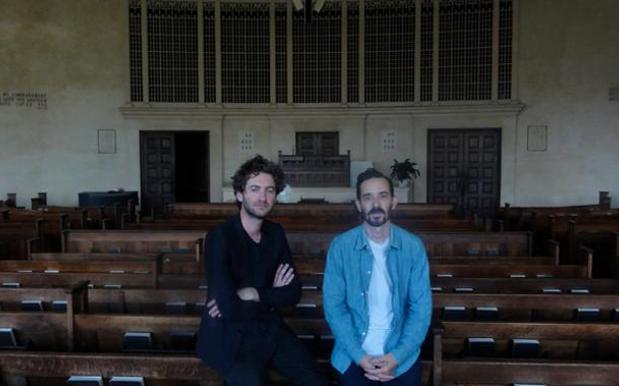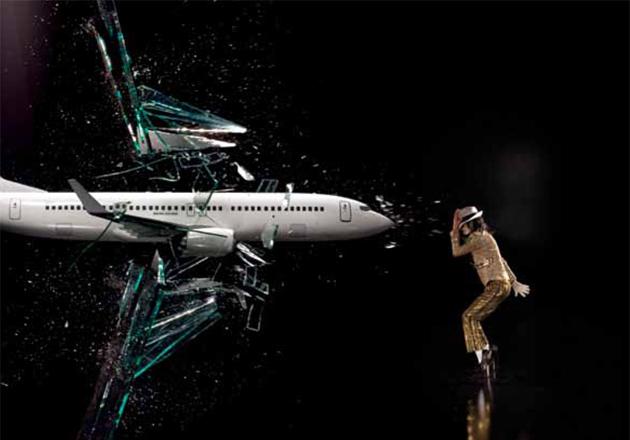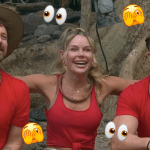
Wednesday marks the first installment of nomadic exhibition series Gallery A.S.. Housed in the disused Christian Science Church in Darlinghurst and spearheaded by Izrock publisher and Monster Children curator Joseph Allen Shea, the first of the roaming exhibition series is Modern Worship, a new body of work by filmmaker Daniel Askill. Galvanized by a three minute short that will play among pews, prayers and pulpits, Askill’s work explores reverence, ritual and popular culture by recontextualizing events such as 9/11 and the death of Michael Jackson with reference to J.G. Ballard’s “The Assassination of John Fitzgerald Kennedy Considered as a Downhill Motor Race”. Last week Pedestrian met with both artist and curator to discuss tragedy, modern idolatry and snowballs.
Pedestrian: Let’s start at the beginning. How do you guys know each other? When did you first meet?
Daniel Askill: I think we first met…Did I know you before London? I remember having met you when you were living in London…
Joseph Allen Shea: That’s when we became friends I don’t know if we knew each other previously. I mean, I’ve lived between here and London a couple of times, and I think we bonded over one New Years Eve party and a little bit of hanging out there.
DA: That was probably ten or so years ago now.
JAS: So I think it’s been long and slow getting to know each other, nothing intense.
DA: Yeah because it was always through friends, and it’s only been the last couple of years really that we started hanging out a bit more.
P: Have you worked together in this capacity before?
JAS: We worked together one time at Monster Children gallery for a show called Artefacts From the Fifth Ritual which was two years ago.
DA: Ever since that show we’ve been having loose conversations about something that could happen.
P: What have you been up to this year?
JAS: This year has been what Gallery A.S. has been and what it could be. Will it be a home for a stable of artists or will it be a project space that roams, do I need to solidify it, have a base…and I kind of just calmed down to a point where I just let it flesh itself out. I was a little bit anxious previously, “I’ve got to have a home, I’ve got to have a stable, it’s got to be a traditional gallery space”. And then I was like calm down, this thing is kind of taking its own life form, you’ve worked with these people before, they have an interest in working with you again, let’s just see the opportunities- and I really wanted to work site specific, work with spaces that don’t usually house art and see how art and artists work with different spaces and locations and emotions and this is really the first part of that.
P: Can you tell us a little bit more about A.S., what’s the ethos behind it?
JAS: It’s still working itself out, but it’s working with my main passions which are artists that who have built their practices from different backgrounds. I’m not shunning academia, but I’m working with people who have worked on commercial levels, or who are self-taught or artists who have built their practice on the street or even outsider artists, you know, moving through the gallery back door in a sense. I think that’s where the most interesting things are happening and new ideas are coming from, rather than going through art school.
P: And Daniel, you’ll be the first in this series, how long has this concept been floating around your brain?
DA: Well I guess in the longer scheme of things, a very long time because it’s part of a bigger, long form film project I’ve been writing with my brother. Working on a feature film can be a really frustrating thing, because it tends to disappear into years and years and years so there was always this idea, that while we were writing it, we’d play with some of the ideas within that material in an art context. So that’s an idea we’ve been kicking around for a couple of years now. But this specific incarnation has probably been around about four or five months. I’m trying to think- because Joe and I got into this habit- I keep a little kayak at my apartment in Elizabeth Bay, and Joe keeps his there too, and some mornings we meet up and we go on the harbor, and I think that’s when the idea sort of evolved, probably about six months ago.
JAS:…Longer. Because I was still living in Elizabeth Bay which was a year or so ago.
DA: ….Ten years ago..
P: You mentioned the film briefly when we spoke to you last, and you were a bit coy with it because film projects tend to not come to fruition sometimes. Can you tell us a bit about the film? Is it narrative based?
DA: It’s becoming more and more narrative based. I’m still probably a bit coy about it for the same reasons. But going back about a year my brother and I finished the first draft of this thing that was super conceptual, and I guess we slowly realized that to get the sort of money we needed, we needed to include some more of the narrative detail. So we spent a few weeks in LA at the end of last year, with a writer over there, so yeah it has becoming more narrative driven, without hopefully compromising the underlying material.

P: The exhibition is about modern day iconography which is driven by celebrity and the internet and all of that. Why did you chose to explore those ideas?
DA: Yeah I think, I guess with all ideas for me, you start to become fascinated with a particular image or idea and in this case there was an idea of a plane crashing through a window and I’ve always been a bit obsessed with Michael Jackson, and I think those things have always stuck in my head as images, without a whole lot of specific meaning behind them initially and I guess over time the ideas that stick snowball. Ideas start clinging to that idea and and it becomes a bit more solid in your head but having said that it’s not meant to be didactic in any way. It’s meant to be aesthetically captivating and if it captivates you aesthetically then hopefully it opens up a door for whoever is looking at it to form their own position. But one thing I kind of reference talking about is this J.G. Ballard story called “The Assassination of John Fitzgerald Kennedy Considered as a Downhill Motor Race”. And that was J.G. Ballard taking a spectacular event and making people look at it with a different perspective by recontextualising it. And this is about that- taking a very tragic spectacle and taking a pop icon spectacle and putting them together in a way that maybe you’re not quite used to seeing and hopefully in doing so making whoever is looking at it shift their perception on both events.
JAS: Tell me if I’m wrong, but these ideas that you have- some disappear and some stay, then things stick to them and snowball. Surely those are the ones that start off as an image but have all this weight around them. So the idea of how the media rules our knowledge, would you say that those are the elements and ideas that stick around longer and tend to snowball because they’re more than just a visual?
DA: Yeah exactly. They’re more than just an image, they’ve got some real weight and depth to them. It’s just the way my mind works I guess. Maybe with some people it hits them with the whole idea but for some reason it always start with something I’m attracted to aesthetically. But if it just stays aesthetic it disappears and you don’t really bother making it but if it hangs there for long enough, all the weight and depth becomes clearer.
JAS: And it becomes worth thinking about and spending time with…
P: A lot of the musicians we interview say similar things. Like they’ll write songs with the focus on aesthetics then retrospectively they’ll notice common themes running through an album. It’s like your mind subconsciously filters what you consider to be important.
DA: Yeah exactly its such an interesting process because I think it really does work like that. You don’t consciously think “I want to make a statement about my relationship that just broke up or the media or pop iconography” you more just have an idea or an abstraction or image, but as said you realize there’s a reason you’re making that image. Otherwise I find that you have the idea, but for some reason you never really execute it.
P: Joe your role as a curator is to facilitate these ideas. How do you plan to incorporate Daniel’s vision into this amazing space?
JAS: It’s definitely an exploration for me like how is this going to work? I don’t know the results and I don’t force the results either. I mean obviously because it’s a place of worship and we’re dealing with idolatry and iconography there’s these parallels; they’re separate and we’re juxtaposing these views of idolatry and religion. I’m just as interested as much as the next person to see how these elements will play off each other. I’m ready for them to shift and morph when we built the instillation.
P: And is it like Daniel’s approach where it’s more intuitive?
JAS: It’ll be intuitive- I think I know where everything’s going, the space brings options to you and windows seem to open up, almost shining light on the wall. I’m ready to be wrong as well, to think, “oh that would work better over there.” That’s why I love working with new galleries, just because I like to work with a different spaces and that’s my favourite part of the job – handling the art and working with the art- that’s the pinnacle.
P: How the hell did you nab this space?
JAS: It was so difficult! This year I’ve just been trying to work out what’s possible so I’ve been meeting with my peers, seeing what they’re up to. It was actually my friend who runs Lo-Fi and we were speaking and he said ‘oh I have this other space, maybe we can work together.’ And I was like “oh yes that’s exactly what I was looking for”.
DA: Yeah, I don’t know he does it either but Joe seems to have his fingers in all these different spaces across town. Joe had taken me to look at all these different amazing buildings and in a way…
JAS: Maybe it’s a different sticky bit to the project – the church was a sticky bit that lumped onto the snowball and it felt right.
P: No it’s almost too appropriate. With the rest of the series, is there a common link that runs through it?
JAS: No it’s still unclear as to what that is. I’m still waiting to talk to other artists. The series won’t have a specific outline, so I’m just working with artists that fit the kind of interests that I mentioned earlier. But the next show will be totally different…I mean I’ve been in all sorts of weird place, a disused sex shop, old supermarkets. I don’t think it’ll be a conscious stream and that’s OK, for each project to exist in its own right.
P: Daniel, was it easy to execute the ideas for this show?
DA: To be honest, we’ve talked about this for a long time, but the pieces themselves have come together quite quickly so it certainly hasn’t been laboured in any way. The idea’s been been gestating for a while but thanks to the nature of the work I produce it hasn’t taken too long to execute. I guess with something like this, the conceptual process goes on for a year, but then fundamentally I go in, shoot it in a day and then editing takes a couple of months. So the execution is relatively contained.
JAS: So if you’re going to spend three hours chopping wood, spend two hours sharpening the axe.
DA: Yeah so it is a bit more cerebral like that.
P: You work a lot with glass and water. What’s the attraction?
DA: I guess I’m drawn to those elemental things.
P: They also trace human movement.
DA: Yeah, well water’s such a primal thing and I find, such a feminine thing. I guess it goes back to a short film I made a few years ago, We Have Decided Not To Die, that dealt with those elemental things. In a way I still love those fundamental building blocks.
P: Yeah I’m not sure how much credit goes to you, but it feels like that look of breaking glass and water is really popular at the moment…
DA: Yeah I have seen that stuff and it’s kind of the culture, to some extent it’s a group collective unconscious, somehow group modes of thought arise and I don’t think that’s a bad thing. Some people feel really ripped off, but I guess at some point there’s that one person who is coming at it from their own integrity. I think it’s nice how there’s that kind of group consciousness.
JAS: And if it is coming from that specific place then every project will look different because one thing that every other artist doesn’t have is your “self”. If you can bring something from an authentic place from yourself it will be honest and unique.
P: As a curator Joe, do you believe in a collective unconscious when it comes to creativity?
JAS: Yeah absolutely. It exists and everyone is worried about who’s referencing who…but over time that stuff will seem insignificant when compared to the fact that a body of work epitomized the 1990s through to 2010s or whatever time period and it represented people living in those time. Over time it won’t seem so petty.
P: What do you get out of this, Daniel? Why do choose to put on exhibitions when your day job is really quite commercial?
DA: A much purer sense of creative satisfaction. There are certain ideas I have that I just need to make one way or another and are not attached to any brief from a brand or a fashion label. I’ve been saying to people recently, it sort of becomes like spinning plates, and that’s what I enjoy, coming here I do a music video, now I need to do something a bit more for myself, but then think, it would be fun to work with something which has a bigger budget, so maybe think about doing a television commercial to pay the rent, but then you come back and do a fashion project or something, you’ve got to go back to the music video before it falls off and crashes. I think if you can keep the balance right and one of them doesn’t become too heavy, they can all feed each other. And at the end of the day the aim is to make a solid piece of work.
P: So is this the closest representation of your head space?
DA: Yeah I’d say definitely. I’m going to be letting a lot of people know about my strange fascination with tragic spectacles and Michael Jackson. I don’t know what it means about my psyche. I think fundamentally some of the elements in this are; I was a huge Michael Jackson fan growing up and when September 11 happened, for me it was such a horrible thing; it was horrible but there was this strange bit of truth in it. This guy said after 9/11 “that was the greatest piece of art for all humanity, ever”. And absolutely that was a pretty misguided thing to say and freaked everyone out, but there was this weird kind of truth in it.
P: As in that event’s ability to change people’s perspectives and sensibilities which is art’s ultimate goal I guess…
DA: Yeah and as a piece of imagery as well that’s loaded with so much weight, that kind of church of economic power which is the World Trade Centers being being hit by this other amazing human construct of this flying machine. Since September 11 there have been so many other tragedies, like just now in Japan the death toll is huge, but it probably won’t resonate over time with quite the same iconic power, because of that image.
P: Even that falling man image, terrible as it is, is just so poetic and strong and iconic. Are you worried that people might think you’re trivializing 9/11?
DA: Hopefully some of the little blurbs that will accompany the show will make that clear, and we reference that J.G. Ballard story, just to show that there is a history of taking events like this and recontextualizing them. And it’s by no means making fun of tragedy or saying 9/11 is equivalent to Michael Jackson’s death. If anything it’s about saying this is the world that we live in now. We get on Youtube and are looking at Michael Jackson’s first moonwalk one second and then the buildings falling down the next. That’s our day to day reality and when we’re on the internet we don’t think twice about that. Maybe when you’re in a church and you come and look at those images put together, maybe it will make you question what your own reality is. So I’m certainly not trying to trivialize it, if anything it’s about trying to open up a door to make people question their own reality. See stuff that they’re used to seeing but through a kaleidoscope.
P: What’s your take Joe?
JAS: I think the way the media presents information is totally skewed against what’s actually happened and what’s realistic and when something else dramatic happens the next week in the news, we’ll forget about something horrific or ongoing struggles elsewhere. I don’t think Daniel is trivializing it at all, he’s just presenting these images in a different context and if someone thinks he’s trivializing it, that’s quite important as well because they’ll start to think “who’s trivializing it?” – the media, themselves, the artist…It’s obviously dangerous ground, but if it provokes that kind of reaction then the art is doing its work.
P: And just for the both of you as well, what’s coming up project-wise?
JAS: More publishing on Izrock. I’ve got a book with the French photographer Benjamin Deberdt and Mark Gonzales, working on top of his photographs, which is very exciting. I’m also doing a publication which will be a bit more broad for the artist French, coming back to church related themes, it will be like a black bible of his dark work, and a few smaller zines, so it looks like we’ll do one with Sam Hodge and a few more curatorial projects of smaller works, and some of them are consulting with brands and institutions.
P: And Daniel what’s next for you?
DA: Oh I’ve just finished a video for Modular and a fashion piece then after that getting this exhibition up and I’m going back to New York to get back to my film. It’s been a busy little period.
DANIEL ASKILL – MODERN WORSHIP
Opening reception Wednesday 20th April 2011 6 – 9pm
Exhibition continues Thursday April 21st – Sunday April 24th 11am – 6pm
Gallery A.S. at The Christian Science Church
Cnr Liverpool Street & Forbes Street, Darlinghurst
Please RSVP to rsvp@gallery.as
After party at Lo-Fi Gallery, Taylor Square from 8pm.



